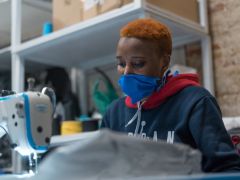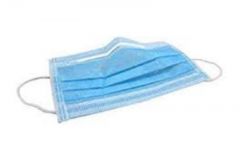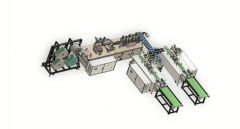Search results for: 'fiber g'
- Related search terms
- fiber
- Fiber op
- Fiber ca
- Fiber machine
- fiber b
-
 D-2388 What’s the Best Material for a Mask?
D-2388 What’s the Best Material for a Mask?Federal health officials have now recommended that we cover our faces with fabric during the coronavirus pandemic. But what material offers the most protection?
The Centers for Disease Control and Prevention has posted a no-sew mask pattern using a bandanna and a coffee filter as well as a video on making masks using rubber bands and folded fabrics found at home.
While a simple face covering can reduce the spread of coronavirus by blocking outgoing germs from coughs or sneezes of an infected person, experts say there is more variation in how much homemade masks might protect the wearer from incoming germs, depending on the fit and quality of the material used.
Scientists around the country have taken it upon themselves to identify everyday materials that do a better job of filtering microscopic particles. In recent tests, HEPA furnace filters scored well, as did vacuum cleaner bags, layers of 600-count pillowcases and fabric similar to flannel pajamas. Stacked coffee filters had medium scores. Scarves and bandanna material had the lowest scores, but still captured a small percentage of particles.
If you don’t have any of the materials that were tested, a simple light test can help you decide whether a fabric is a good candidate for a mask.
“Hold it up to a bright light,” said Dr. Scott Segal, chairman of anesthesiology at Wake Forest Baptist Health who recently studied homemade masks. “If light passes really easily through the fibers and you can almost see the fibers, it’s not a good fabric. If it’s a denser weave of thicker material and light doesn’t pass through it as much, that’s the material you want to use.”
Researchers say it’s important to remember that lab studies are conducted under perfect conditions with no leaks or gaps in the mask, but the test methods give us a way to compare materials. And while the degree of filtration for some homemade masks seems low, most of us — who are staying home and practicing social distancing in public — don’t need the high level of protection required for medical workers. More important, any face covering is better than none, especially if worn by a person who has the virus but doesn’t know it.
The biggest challenge of choosing a homemade mask material is to find a fabric that is dense enough to capture viral particles, but breathable enough that we can actually wear it. Some items being touted online promise high filtration scores, but the material would be unwearable.
Dressing Up for Work … at Home
Yang Wang, an assistant professor of environmental engineering at Missouri University of Science and Technology, worked with his graduate students to study various combinations of layered materials — including both air filters and fabric. “You need something that is efficient for removing particles, but you also need to breathe,” said Dr. Wang, who last fall won an international award for aerosol research.To test everyday materials, scientists are using methods similar to those used to test medical masks, which everybody agrees should be saved for medical workers who are exposed to high doses of virus from seeing infected patients. The best medical mask — called the N95 respirator — filters out at least 95 percent of particles as small as 0.3 microns. By comparison, a typical surgical mask — made using a rectangular piece of pleated fabric with elastic ear loops — has a filtration efficiency ranging from 60 to 80 percent.
Dr. Wang’s group tested two types of air filters. An allergy-reduction HVAC filter worked the best, capturing 89 percent of particles with one layer and 94 percent with two layers. A furnace filter captured 75 percent with two layers, but required six layers to achieve 95 percent. To find a filter similar to those tested, look for a minimum efficiency reporting value (MERV) rating of 12 or higher or a microparticle performance rating of 1900 or higher.
The problem with air filters is that they potentially could shed small fibers that would be risky to inhale. So if you want to use a filter, you need to sandwich the filter between two layers of cotton fabric. Dr. Wang said one of his grad students made his own mask by following the instructions in the C.D.C. video, but adding several layers of filter material inside a bandanna.
Dr. Wang’s group also found that when certain common fabrics were used, two layers offered far less protection than four layers. A 600 thread count pillow case captured just 22 percent of particles when doubled, but four layers captured nearly 60 percent. A thick woolen yarn scarf filtered 21 percent of particles in two layers, and 48.8 percent in four layers. A 100 percent cotton bandanna did the worst, capturing only 18.2 percent when doubled, and just 19.5 percent in four layers.
The group also tested Brew Rite and Natural Brew basket-style coffee filters, which, when stacked in three layers, showed 40 to 50 percent filtration efficiency — but they were less breathable than other options.
If you are lucky enough to know a quilter, ask them to make you a mask. Tests performed at the Wake Forest Institute for Regenerative Medicine in Winston-Salem, N.C., showed good results for homemade masks using quilting fabric. Dr. Segal, of Wake Forest Baptist Health, who led the study, noted that quilters tend to use high-quality, high-thread count cotton. The best homemade masks in his study were as good as surgical masks or slightly better, testing in the range of 70 to 79 percent filtration. Homemade masks that used flimsier fabric tested as low as 1 percent filtration, Dr. Segal said.
The best-performing designs were a mask constructed of two layers of high-quality, heavyweight “quilter’s cotton,” a two-layer mask made with thick batik fabric, and a double-layer mask with an inner layer of flannel and outer layer of cotton.
Bonnie Browning, executive show director for the American Quilter’s Society, said that quilters prefer tightly woven cottons and batik fabrics that stand up over time. Ms. Browning said most sewing machines can handle only two layers of fabric when making a pleated mask, but someone who wanted four layers of protection could wear two masks at a time.
Ms. Browning said she recently reached out to quilters on Facebook and heard from 71 people who have made a combined total of nearly 15,000 masks. “We quilters are very much in the thick of what’s going on with this,” said Ms. Browning, who lives in Paducah, Ky. “One thing most of us have is a stash of fabric.”
People who don’t sew could try a folded origami mask, created by Jiangmei Wu, assistant professor of interior design at Indiana University. Ms. Wu, who is known for her breathtaking folded artwork, said she began designing a folded mask out of a medical and building material called Tyvek, as well as vacuum bags, after her brother in Hong Kong, where mask wearing is common, suggested it. (DuPont, the maker of Tyvek, said in a statement that Tyvek is intended for medical apparel, not masks.) The folded mask pattern is free online, as is a video demonstrating the folding process. In tests at Missouri University and University of Virginia, scientists found that vacuum bags removed between 60 percent and 87 percent of particles. But some brands of vacuum bags may contain fiberglass or are harder to breathe through than other materials, and shouldn’t be used. Ms. Wu used a bag by EnviroCare Technologies, which has said it does not use fiberglass in its paper and synthetic cloth bags.
“I wanted to create an alternative for people who don’t sew,” said Ms. Wu, who said she is talking to various groups to find other materials that will be effective in a folded mask. “Given the shortage of all kinds of materials, even vacuum bags might run out.”
The scientists who conducted the tests used a standard of 0.3 microns because that is the measure used by the National Institute for Occupational Safety and Health for medical masks.
Linsey Marr, a Virginia Tech aerosol scientist and an expert in the transmission of viruses, said the certification method for respirators and HEPA filters focuses on 0.3 microns because particles around that size are the hardest to catch. While it seems counterintuitive, particles smaller than 0.1 microns are actually easier to catch because they have a lot of random motion that makes them bump into the filter fibers, she said.
“Even though coronavirus is around 0.1 microns, it floats around in a wide range of sizes, from around 0.2 to several hundred microns, because people shed the virus in respiratory fluid droplets that also contain lots of salts and proteins and other things,” said Dr. Marr. “Even if the water in the droplets fully evaporates, there’s still a lot of salt and proteins and other gunk that stays behind as solid or gel-like material. I think 0.3 microns is still useful for guidance because the minimum filtration efficiency will be somewhere around this size, and it’s what NIOSH uses.”
Learn More -
 H-2386 ONE-PIECE MASK MANUFACTURING MACHINES
H-2386 ONE-PIECE MASK MANUFACTURING MACHINESONE-PIECE MASK MACHINERY, MADE ON HOSIERY MACHINES
REBUILT, RECONVERTED & UPDATED INTO MACHINES FOR ONE-PIECE MASKSSINGLE CYLINDER MACHINES
WITH FULLY ELECTRONIC CONTROL
DIAMETER: 4”
NEEDLES: 200 TO 400
FEEDS: 4KNITTING PRODUCTION:
• MASKS READY TO WEAR IN ANY SIZE & STYLE
• THEY ARE PRODUCED USING ANY NATURAL YARN,
ECOLOGICAL YARN, ANTIBACTERIAL FIBER, STRETCH FIBERS
• CAN BE CUSTOMIZED WITH DESIGNS, COLORS, LOGOS
• PRODUCTION TIME: FROM 45 SECONDS PER MASKPLAIN FABRIC, RUN PROOF, MICROMESH, NET, REINFORCED BAND, REINFORCED & FLOATED PATTERNS
SINKER CAP WITH STEPPING MOTOR
MASKS ARE COMPLETE WITH A TUBULAR POCKET FOR INSERTING FILTER OR ADDITIONAL FABRIC FOR BETTER PREVENTION
-TUBULAR POCKET DIMENSIONS: 50 X 100mm (FILTERS MAY ALSO BE ROUND SHAPE)
MACHINE WASHABLE AND REUSABLE
MOTORIZED DIAL ARM WITH VERTICAL MOVEMENT THROUGH STEPPING MOTOR FOR
UNLIMITED HEIGHT POSITIONSSTITCH CAMS WITH INDEPENDENT VARIABLE PROFILE SYSTEM
SYSTEM ON YARN FINGERS FOR PLATING CONTROL
ELECTRONIC NEEDLES & NEEDLES SELECTION ON 4 FEEDS
PROGRAMMABLE & VARIABLE STITCH CAM LOWERING IN DIFFERENT AREAS
BY STEPPING MOTOR ON EACH FEED
ALL FUNCTIONS ELECTRONICALLY CONTROLLED
PROGRAMMING STYLES & SIZE, PATTERNS EDITING & STITCH CAM LOWERING BY PERSONAL COMPUTER
AND POWERFUL GRAPHIC SOFTWARE FOR WINDOWS ENVIRONMENT.
KEYBOARD WITH GRAPHIC DISPLAY FOR SELECTION OF STYLE, SIZE , PATTERNS & OTHER FUNCTION
PRE-SETTING AND PROGRAMMING FOR DIFFERENT KINDS OF YARNS FEEDING DEVICEDIMENSIONS: 1000mm L x 1000mm W x 2500mm H
Learn More
SHIPPING WEIGHT: 350 KG, ON PALLETS
SHIPPING DIMENSIONS: 1000mm L x 1000mm W x 2000mm H
DELIVERY TIME FOR 1 TO 10 MACHINES: 3 TO 4 WEEKS FROM PAYMENT (3/27) -
 J-2795 DISPOSABLE FACE MASKS, 3-PLY SPUNBOND-MELTBLOWN-SPUNBOND, 50 PIECES PER BOX
J-2795 DISPOSABLE FACE MASKS, 3-PLY SPUNBOND-MELTBLOWN-SPUNBOND, 50 PIECES PER BOXDISPOSABLE FACE MASKS
MATERIAL: 3-PLY (100% VIRGIN FIBER)
1ST LAYER NONWOVEN PP SPUNBOND
2ND LAYER NONWOVEN PP MELTBLOWN
3RD LAYER NONWOVEN PP SPUNBOND
MASK SIZE: 175mm x 95mm (ADULT SIZE)
WEIGHT: 2.9 TO 3.2 GRAMS EACH
50 PIECES PER BOX / 40 BOXES PER CARTON
• LOW BREATHING RESISTANCE
• SOFT LINING, NON-IRRITATING TO SKIN
• FIBERGLASS FREE AND LATEX FREE
• WITH ADJUSTABLE NOSE BRIDGE SUPPORT PIECE
• WITH ELASTIC EAR LOOPSQUANTITY: 50,000 PIECES OF FRESH STOCK CURRENTLY AVAILABLE
Learn More -
 J-2730 AUTOMATIC DISPOSABLE SURGICAL MASK (N95) PRODUCTION LINE WITH PACKAGING -PRODUCES SURGICAL MASKS WITH FILTRATION EFFICIENCY OF NO LESS THAN 95% -CAPACITY: 50 MASKS (N95) PER MINUTE
J-2730 AUTOMATIC DISPOSABLE SURGICAL MASK (N95) PRODUCTION LINE WITH PACKAGING -PRODUCES SURGICAL MASKS WITH FILTRATION EFFICIENCY OF NO LESS THAN 95% -CAPACITY: 50 MASKS (N95) PER MINUTEITEM 001 - MASK PRODUCTION MACHINE WITH (2) ULTRASONIC EAR STRAP WELDING DEVICES
FOR THE PRODUCTION OF SURGICAL MASKS WITH FILTRATION EFFICIENCY OF NO LESS THAN 95% (N95)
CAPACITY: 50 FOLDED N95 MASKS PER MINUTE
MASK DIMENSIONS: 175mm x 95mm
MATERIAL TYPE: 3 LAYERS OF POLYPROPYLENE NONWOVEN COMPOSITE FIBER
OPERATION CONTROLLED BY LCD TOUCH SCREEN
AUTOMATICALLY ALIGNS 3 ROLLS OF MATERIAL TO FEED IN (OUTER, FILTER AND INNER LAYERS)
PRESSES BOTH SIDES TOGETHER SYMMETRICALLY WHILE WELDING WITH ULTRASONIC HEAD
SPLITS TO 2 SERPATE WELDING DEVICES FOR EARLOOPS AND SENDS TO DIGITAL COUNTER
EARLOOPS ARE FINISHED WITH ULTRASONIC CUTTING AND WELDING
NOSE BRIDGE CAN BE PRODUCED WITH AUTOMATIC FEEDING, CUTTING AND ULTRASONIC WELDING
ULTRASONIC HEADS
VOLTAGE: 220 VOLTS
WATTS CAPACITY: 1500 WATT
FREQUENCY (KHZ): 20 KHZ
WARRANTY PERIOD FOR HEADS: 1 YEAR
COMPONENT MANUFACTURERS
SERVO MOTOR: PANASONIC / SCHNEIDER
CONTROL SYSTEM: PROPRIETARY
ULTRASONIC GENERATOR: PROPRIETARY, 220 VOLTS, 1.5 KW, 20 KHZ
SENSOR: OMRON / SICK
PNEUMATIC COMPONENT: SMC / FESTO
BELT: SAMSUNG / BANDO
MAIN BODY: PRE-MADE MATERIAL, WELDED ASSEMBLY
BEARINGS: NSK
BALL SCREWS: HIWIN
SECURITY DEVICE: SICK (SAFETY DEVICES TO PROTECT WORKERS)
TOTAL POWER: 4 KW
MACHINE MUST BE STOPPED TO FEED NEW ROLL OF MATERIAL
END OF ROLL DETECTOR INCLUDED: WHEN FABRIC IS FINISHED THE MACHINE WILL ALARM AND STOP
AIR PRESSURE: 0.6 MPa
VOLTAGE: 220 VOLTS, 60 Hz
DIMENSIONS: 6400mm x 4700mm x 1700mm
INCLUDES ELECTRONIC MANUAL BOOK (STORED ON USB MEMORY) AND WARRANTY CARD
OPTIONS (INQUIRE FOR PRICING): EAR STRAP FOLDER
ITEM 001 QUANTITY: 1 MASK PRODUCTION MACHINE AND 2 ULTRASONIC WELDING DEVICES FOR EAR STRAPS
ITEM 002 AUTOMATIC BAGGING MACHINE
SUITABLE FOR AUTOMATIC BAGGING OPERATIONS FOR VARIOUS MASK TYPES
MOTOR CONTROL SYSTEM: SERVO (3), AUTOMATICALLY SETS BAG LENGTH (UP TO 400mm) FOR SPECIFIED BAGGING LENGTH, WITH ANTI-AIR BAG , AUTOMATICALLY DETECTS PRODUCT BASE POINT AND MATERIAL POSITION, AUTOMATIC STOP WHEN OUT OF MATERIAL & STARTS WHEN MATERIAL IS PRESENT
FAST & CONVENIENT SETTING OF PARAMETERS, STORES SETS OF PARAMETERS FOR MULTIPLE PRODUCTS, OPERATOR CAN CHOOSE PARAMETERS ACCORDING TO PRODUCT SIZES
DIAGNOSTICS SYSTEM CLEARS ERROR & RESETS IN SINGLE STEP
HIGHLY SENSITIVE PHOTOELECTRIC EYE COLOR MARK TRACKER, DIGITAL INPUT SEAL/CUT POSITION MAKES SEAL & CUT POSITIONS MORE ACCURATE
TEMPERATURE CONTROLLED WITH INDEPENDENT PID, ALLOWS FOR VARIOUS MATERIALS IN PACKAGING
SIMPLE TRANSMISSION SYSTEM ALLOWS FOR EASY MAINTENANCE AND RELIABILITY
ALL CONTROLS SET BY SOFTWARE ALLOWING FOR ADJUSTING OF FUNCTIONS AND UPGRADES
MATERIALS
PVC FILM (HEAT SEALING), BOPP, OPP, CPP, ALUMINIZED PET FILM, ALUMINUM-PLASTIC FILM, PAPER FILM, PAPER GLUE, OTHER SINGLE- OR MULTIPLE-LAYERED HEAT-SEALED DIALYZABLE MATERIALS, ETC.
LENGTH OF PACKAGE BAGS: ≤400mm
WIDTH OF PACKAGE BAGS: 100 TO 165mm
HEIGHT OF PRODUCT: 55mm MAXIMUM
LENGTH OF FILM: 360mm MAXIMUM
DIAMETER OF FILM ROLL: 320mm MAXIMUM
CAPACITY/SPEED OF PACKAGING: 40 TO 230 BAGS PER MINUTE (1 TO 20 PIECES PER BAG)
POWER: 220 VOLTS, 50 OR 60 Hz, 2.4 KW
DIMENSIONS: 4050mm x 750mm x 1450mm
WEIGHT: APPROXIMATELY 300 KGS
COMPONENT MANUFACTURERS
TOUCH SCREEN: WEINVIEW
SERVO MOTOR: DORNA / WEIDE
SERVO CONTROLLER: DORNA / WEIDE
PROXIMITY SWITCH: OMRON
PHOTOELECTRIC SWITCH: OETAI
TEMPERATURE CONTROLLER: YATAI
SOLID STATE RELAY: SCHNEIDER
INTERMEDIATE RELAY: WEIDMUELLER
OPTIONS, INQUIRE FOR PRICING: STRAIGHT GRAIN SEALING, STAINLESS STEEL FRAME, CODE STAMPER (PRODUCTION DATE), EXHAUST (PINHOLE EXHAUST FEATURE)
ITEM 002 QUANTITY: 1 BAGGING MACHINE
ENTIRE LINE COMPOSED OF ITEM 001 AND ITEM 002
Learn More
